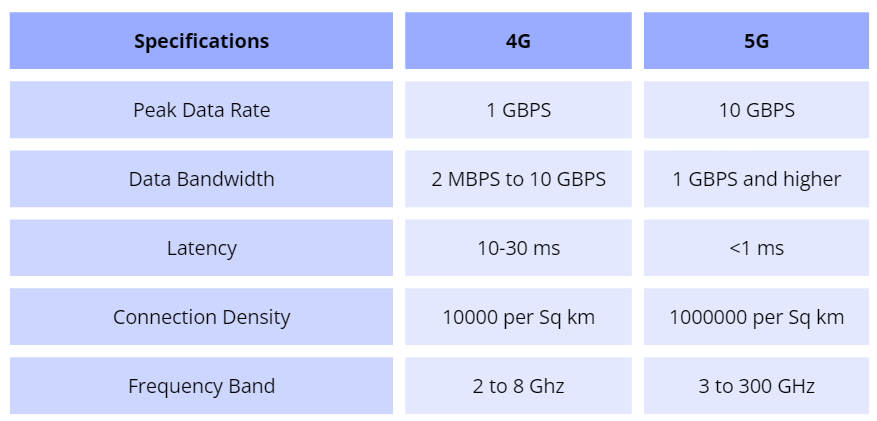In today’s world, technology has become an essential part of military operations. The application of 5G in defence networks is already making waves globally. This next-generation wireless technology has the potential to revolutionize the Defence network. It promises not only unprecedented speeds but also reliability and connectivity.
But how exactly can the Military extract its potential? Let us examine the details and uncover how 5G can revolutionize Defence Networks.

Fig 1: Comparison between 4G and 5G
Before we explore the application for the Military, let us try to understand 5G.
5G, the abbreviation for the fifth generation of mobile networks, represents a significant jump in wireless communication technology. Unlike its predecessors, 5G is predominantly wireless, offering unmatched speeds, capacity, and reliability. It can support up to a million devices per square kilometer, a significant improvement compared to the only one thousand devices per square kilometer supported by 4G networks.
With its revolutionary features and capabilities, 5G’s application in defence networks holds immense promise for transforming military operations and defence strategies. With its ultra-reliable and low-latency communications, 5G offers a solid foundation for enhancing tactical communications, network segmentation, autonomous systems, augmented reality training, real-time surveillance, and extending connectivity to remote areas through satellite-enabled networks.
Let us look at some of the key features of 5G in detail:
It is believed that 5g will bring a digital revolution to the battlefield. This competitive edge is made possible by the availability of ultra-high data rates and virtually instantaneous transmissions.
Let us delve into some of the applications of 5G networks in defence:
5G is designed to provide seamless and secure communication channels for armed forces in the field. From real-time battlefield coordination to ad hoc networks in emergencies, it promises a very reliable connectivity and hence improving situational awareness and operational efficiency
Defense networks usually require a very strict segmentation and prioritization to ensure critical operations receive optimal network resources. 5G network can be sliced into various layers, allowing different applications and user groups to operate independently while maintaining security and quality of service.
5G networks can support the connectivity and data transfer requirements of autonomous vehicles and drones, allowing for remote operation and control in battlefield scenarios, thus reducing risks to human operators.
One of 5G’s capabilities is powering Augmented Reality (AR). Armed forces on the field can utilize AR technology to simulate various training scenarios, thus improving situational awareness and training effectiveness.
The high-speed data transmission and low latency of 5G technology allow armed forces to deploy surveillance systems that provide real-time intelligence on enemy movements and activities. This, in turn, enhances intelligence and tactical decision-making.
5G can also enable Satellite Communication. It can extend coverage to remote areas and provide critical connectivity for tactical military users and first responders. Non-terrestrial networks (NTNs) leverage space-borne assets to deliver ubiquitous cellular coverage, empowering military operations in previously inaccessible regions.
Now let’s look at specific cases where various military organizations worldwide are exploiting the potential of 5G to achieve profound levels of operational efficiency and strategic agility on the battlefield.
It is essential to recognize the profound impact of 5G in defence, especially concerning modern defense operations and strategies. With its revolutionary features and capabilities, 5G has emerged as a cornerstone for transforming how armed forces communicate, coordinate, and conduct missions.